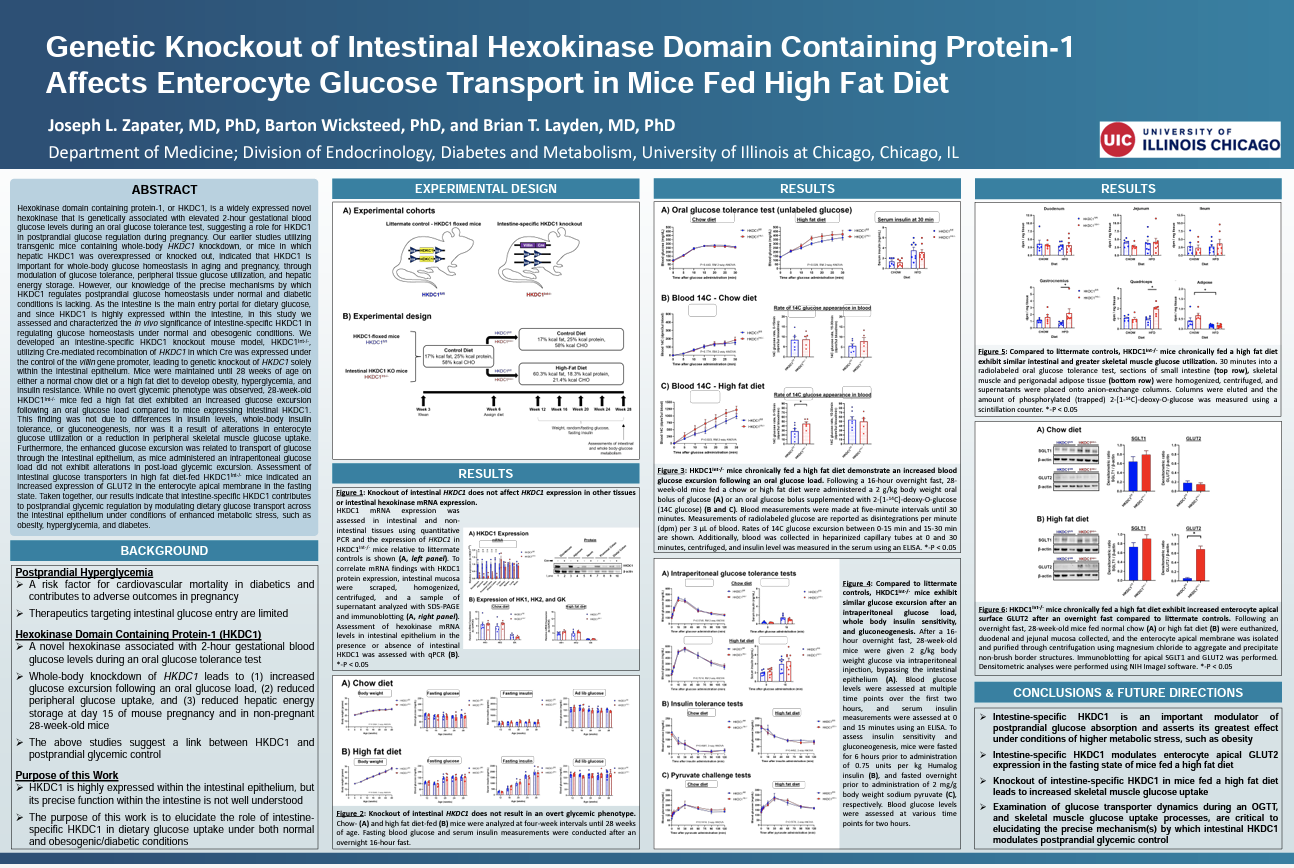Poster # 4
GENETIC KNOCKOUT OF INTESTINAL HEXOKINASE DOMAIN CONTAINING PROTEIN-1 AFFECTS ENTEROCYTE GLUCOSE TRANSPORT IN MICE FED HIGH FAT DIET
Co-authors: Joseph L. Zapater, UIC; Barton Wicksteed, UIC; Brian T. Layden, UIC
PRESENTER’S INFO:
Name: Joseph Zapater
Email: jzapat4@uic.edu
Title: Faculty
Affiliation: University of Illinois Chicago
Department: Medicine-Endocrinology
Advisor: Dr. Brian Layden
Advisor’s Email: blayde1@uic.edu
Abstract:
Hexokinase domain containing protein-1 (HKDC1) is a widely expressed hexokinase associated with elevated 2-hour gestational blood glucose levels during an oral glucose tolerance test, suggesting a role in postprandial glucose regulation during pregnancy. Our earlier studies utilizing a whole-body HKDC1 knockdown mouse model indicated that HKDC1 is important for glucose homeostasis in aging and pregnancy, through modulation of glucose tolerance and peripheral tissue glucose utilization. However, our knowledge of the mechanisms by which HKDC1 regulates postprandial glucose homeostasis under normal and diabetic conditions is lacking. In this study, we assessed the in vivo significance of intestine-specific HKDC1 in regulating glucose homeostasis under normal and obesogenic conditions. We developed an intestine-specific HKDC1 knockout mouse model, HKDC1Int-/-, utilizing Cre-lox recombination of HKDC1. Mice were maintained until 28 weeks of age on either a normal chow or a high fat diet to develop obesity, hyperglycemia, and insulin resistance. While no overt glycemic phenotype was observed, 28-week-old HKDC1Int-/- mice fed high fat diet exhibited an increased glucose excursion following an oral glucose load compared to mice expressing intestinal HKDC1. This finding was not due to differences in insulin levels, whole-body insulin tolerance, or gluconeogenesis, nor was it a result of alterations in enterocyte glucose utilization or a reduction in peripheral skeletal muscle glucose uptake. Furthermore, the enhanced glucose excursion was related to transport of glucose through the intestinal epithelium, as mice administered an intraperitoneal glucose load did not exhibit alterations in post-load glycemic excursion. Assessment of intestinal glucose transporters in high fat diet-fed HKDC1Int-/- mice indicated an increased expression of GLUT2 in the enterocyte apical membrane in the fasting state. Taken together, our results indicate that intestine-specific HKDC1 contributes to postprandial glycemic regulation by modulating dietary glucose transport across the intestinal epithelium under conditions of enhanced metabolic stress, such as obesity, hyperglycemia, and diabetes.
Poster: To download / open the poster as a PDF file in a new window click on the image below.
No Fields Found.

